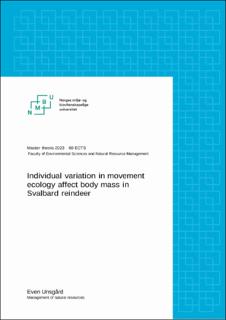| dc.description.abstract | Herbivore foraging is a complex interaction mainly driven by the distribution of forage in the landscape. The forage quantity and quality in the habitat influences the establishment of home ranges and diet selection from patches down to fine scale choices of plant species and plant parts. When vegetation biomass is plentiful, herbivores can feed selectively to increase the daily intake rate of digestible matter. Selective feeding that adds only small incremental gains may over time cause large gains in fitness, the so-called multiplier effect. This makes individual movement ecology a crucial aspect of foraging behaviour. Patch residence time (PRT) provides a measure of the time a herbivore stays in a patch before moving on to feed elsewhere and may serve as an estimate of how selective an individual is.
In this study I utilized GPS collar data from 10 culled female Svalbard reindeer (Rangifer tarandus platyrhynchus) to document PRT as an indicator of foraging behaviour to relate individual movement ecology to October body mass. In addition, I investigated if individual variation in PRT has a carry-over effect on late winter body mass (April) by using capture and GPS-data from 156 individual years. Finally, I explored how PRT correlates with yearly plant biomass level, visually assessed foraging behaviour and home range size.
I found that individuals with lower PRT were significantly heavier in October, the individual with the lowest PRT (2.9h) was 5.5 kg lighter compared to the reindeer with the highest PRT (5.8h). There was a positive carry-over effect of lower cumulative PRT to late winter body mass and cumulative PRT increased in warmer summers when plant biomass is likely to be greater. Mean daily PRT was negatively correlated with time spent walking grazing and positively correlated with time spent standing grazing. Lastly, home range size decreased with increasing cumulative PRT.
This is the first study to relate PRT from GPS data to individual foraging behaviour and highlights how movement ecology is important for fitness. More selective grazing yields a higher energy return in a heterogenous habitat and small differences between individuals in daily foraging behaviour has a multiplier effect and results in higher body mass. Overall, this study provides evidence of individual foraging benefits through a novel approach of herbivore foraging behaviour research. By using GPS data to quantify the effects of relatively small-scaled feeding strategies body mass, a key determinant of fitness. | |
